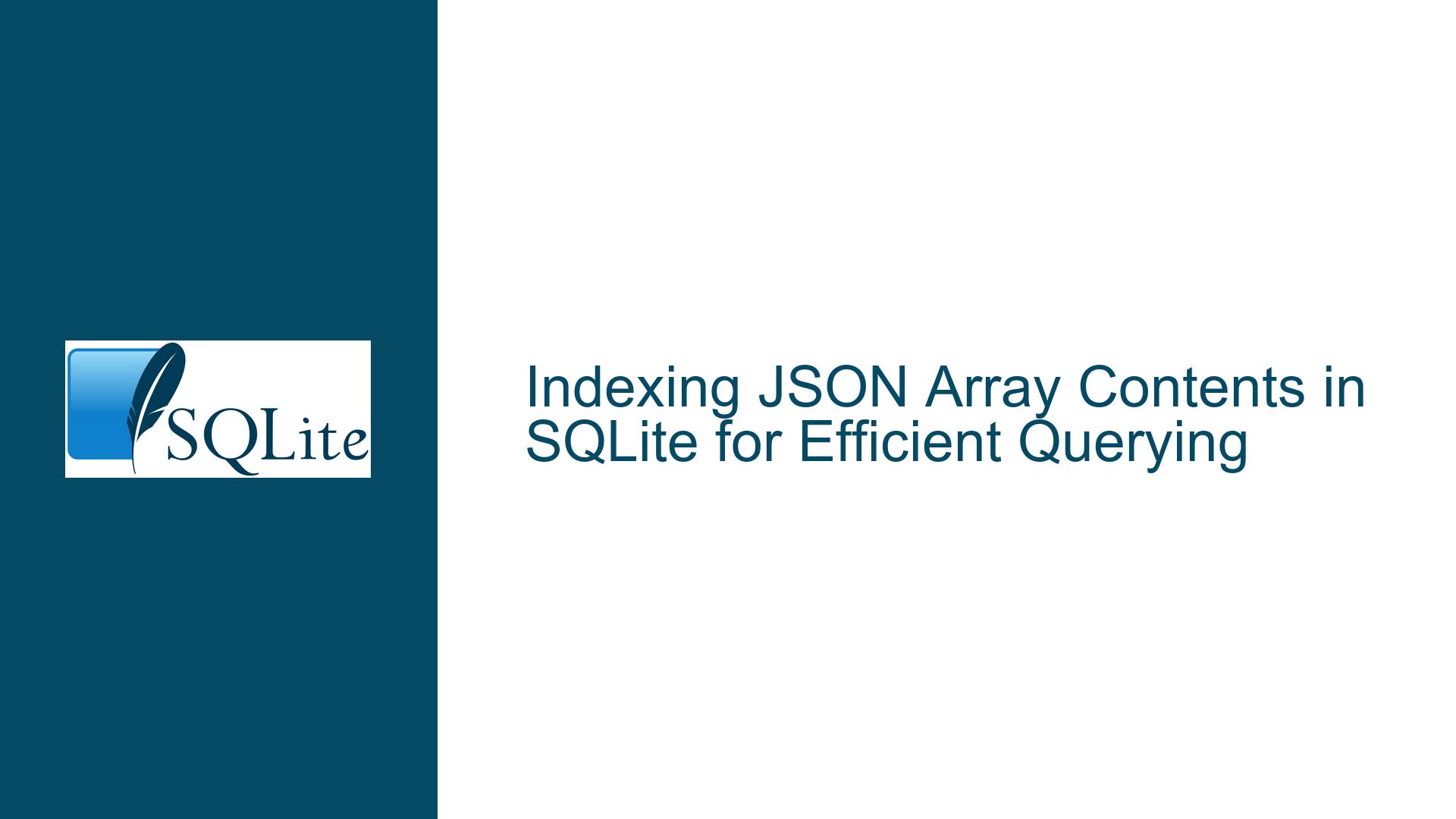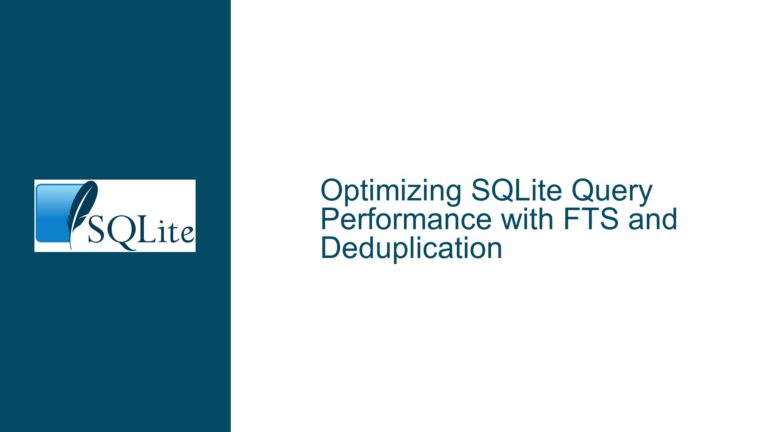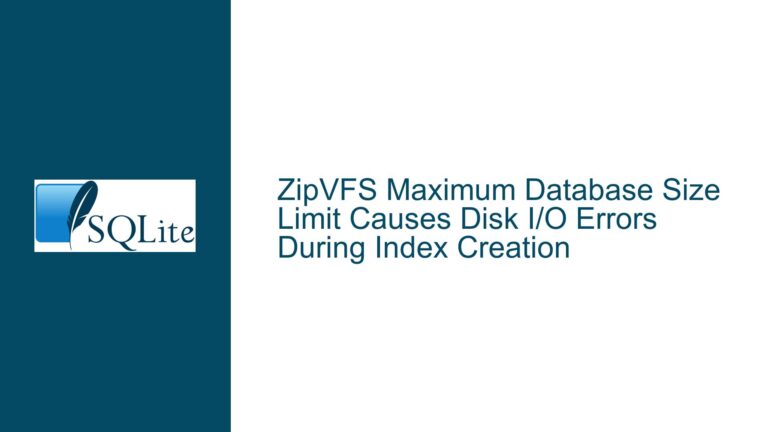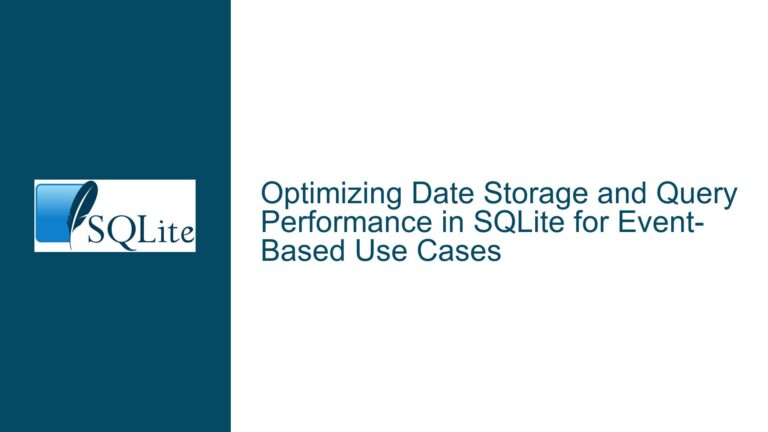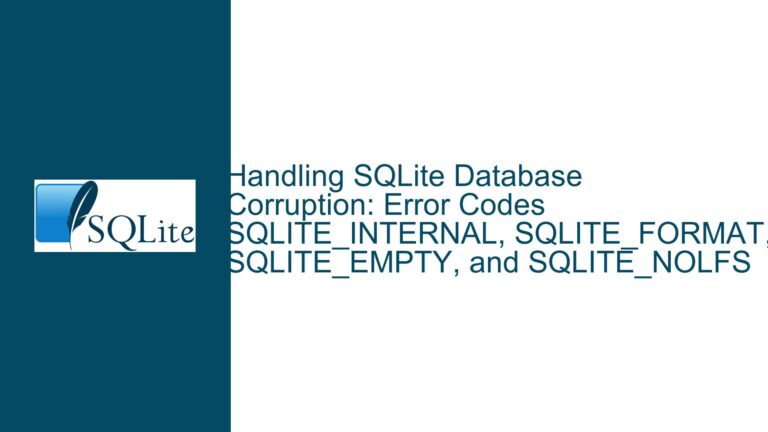Indexing JSON Array Contents in SQLite for Efficient Querying
JSON Array Query Performance Limitations in SQLite
When working with JSON arrays stored in SQLite, one common challenge is efficiently querying the contents of these arrays. SQLite’s JSON1 extension provides powerful tools for parsing and querying JSON data, but it has limitations when it comes to indexing the contents of JSON arrays. Specifically, SQLite does not natively support indexing individual elements within a JSON array, which can lead to performance bottlenecks when querying large datasets.
Consider a scenario where a table test stores JSON arrays in a text column, and you need to find all rows where a specific value (e.g., 'a') exists anywhere within the array. The query might look like this:
SELECT name FROM test
WHERE EXISTS (
SELECT *
FROM json_each(test.array)
WHERE json_each.value = 'a'
);
This query works by iterating over each element in the JSON array using the json_each table-valued function. However, since SQLite cannot create an index on the individual elements of the JSON array, the query must scan the entire array for each row in the table. This results in a full table scan, which is inefficient for large datasets.
The core issue is that SQLite’s indexing mechanism is inherently one-to-one: each row in the table corresponds to one entry in the index. However, querying JSON arrays requires a many-to-one relationship, where multiple elements in the array (many) correspond to a single row in the table (one). This mismatch makes it difficult to create a traditional index that speeds up such queries.
Interrupted Write Operations Leading to Index Corruption
One of the primary reasons for the lack of native support for indexing JSON array contents is the complexity of maintaining such an index. Traditional indexes in SQLite are designed to handle straightforward column values, not nested or hierarchical data structures like JSON arrays. When dealing with JSON arrays, maintaining an index would require updating the index every time the array is modified, which can be computationally expensive and error-prone.
For example, if an index were created on the elements of a JSON array, any insertion, deletion, or update to the array would require the index to be recalculated. This could lead to performance degradation, especially for large arrays or frequent updates. Additionally, if the database were to crash or experience a power failure during an update, the index could become corrupted, leading to data integrity issues.
Another challenge is that JSON arrays can contain heterogeneous data types, making it difficult to define a consistent indexing strategy. For instance, an array might contain strings, numbers, and nested objects, each requiring different indexing approaches. This heterogeneity complicates the creation of a universal index that can efficiently handle all possible array contents.
Implementing Triggers and Auxiliary Tables for Indexing JSON Arrays
To overcome the limitations of native JSON array indexing in SQLite, one effective approach is to use auxiliary tables and triggers to manually maintain an index of the array elements. This method involves creating a separate table to store the individual elements of the JSON array, along with a foreign key reference to the original table. Triggers are then used to keep the auxiliary table in sync with the original table.
Step 1: Create the Original Table
The first step is to create the original table that stores the JSON arrays. For example:
CREATE TABLE test (
id INTEGER PRIMARY KEY NOT NULL,
name TEXT,
array TEXT NOT NULL
);
This table includes an id column as the primary key, a name column for descriptive purposes, and an array column to store the JSON arrays.
Step 2: Create the Auxiliary Index Table
Next, create an auxiliary table to store the individual elements of the JSON arrays. This table will include a foreign key reference to the original table:
CREATE TABLE test_idx (
fid INTEGER NOT NULL,
elem TEXT NOT NULL,
PRIMARY KEY(fid, elem),
FOREIGN KEY(fid) REFERENCES test(id)
);
In this table, fid is a foreign key that references the id column in the test table, and elem stores the individual elements of the JSON array. The primary key is a composite key consisting of fid and elem, ensuring that each element is uniquely associated with a specific row in the test table.
Step 3: Create Triggers to Maintain the Index
To keep the auxiliary table in sync with the original table, create triggers that automatically update the test_idx table whenever the test table is modified. The following triggers handle insertions, deletions, and updates:
CREATE TRIGGER test_ai AFTER INSERT ON test BEGIN
INSERT INTO test_idx(fid, elem)
SELECT new.id, j.value
FROM json_each(new.array) AS j;
END;
CREATE TRIGGER test_ad AFTER DELETE ON test BEGIN
DELETE FROM test_idx WHERE fid = old.id;
END;
CREATE TRIGGER test_au AFTER UPDATE ON test BEGIN
DELETE FROM test_idx WHERE fid = old.id;
INSERT INTO test_idx(fid, elem)
SELECT new.id, j.value
FROM json_each(new.array) AS j;
END;
These triggers ensure that the test_idx table is always up-to-date with the contents of the JSON arrays in the test table. The test_ai trigger inserts new elements into the test_idx table whenever a new row is added to the test table. The test_ad trigger removes elements from the test_idx table when a row is deleted from the test table. The test_au trigger updates the test_idx table when a row in the test table is modified.
Step 4: Querying the Auxiliary Table
With the auxiliary table and triggers in place, you can now efficiently query the contents of the JSON arrays. For example, to find all rows in the test table that contain the value 'a' in their JSON array, you can use the following query:
SELECT name FROM test
WHERE id IN (
SELECT fid FROM test_idx WHERE elem = 'a'
);
This query leverages the index on the elem column in the test_idx table, resulting in significantly faster performance compared to the original query that used json_each.
Step 5: Optimizing the Auxiliary Table
To further optimize the performance of queries on the auxiliary table, consider adding an index on the elem column:
CREATE INDEX idx_elem ON test_idx(elem);
This index allows for even faster lookups when querying specific elements in the JSON arrays.
Step 6: Handling Non-Unique Array Elements
If the JSON arrays contain non-unique elements, you may need to adjust the primary key constraint in the test_idx table. Instead of using a composite key of fid and elem, you can introduce a new primary key column and remove the composite key constraint:
CREATE TABLE test_idx (
id INTEGER PRIMARY KEY AUTOINCREMENT,
fid INTEGER NOT NULL,
elem TEXT NOT NULL,
FOREIGN KEY(fid) REFERENCES test(id)
);
This modification allows the test_idx table to store multiple occurrences of the same element within a single JSON array.
Step 7: Considering Full-Text Search for Textual Data
If the JSON arrays primarily contain textual data, another approach is to use SQLite’s Full-Text Search (FTS5) extension. FTS5 is designed for efficient text searching and can be used to index the contents of JSON arrays. However, this approach requires manual maintenance of the full-text index, as it does not automatically update when the JSON arrays are modified.
To use FTS5, create a virtual table and populate it with the contents of the JSON arrays:
CREATE VIRTUAL TABLE test_fts USING fts5(id, elem);
Then, use triggers to keep the FTS5 table in sync with the test table:
CREATE TRIGGER test_ai_fts AFTER INSERT ON test BEGIN
INSERT INTO test_fts(id, elem)
SELECT new.id, j.value
FROM json_each(new.array) AS j;
END;
CREATE TRIGGER test_ad_fts AFTER DELETE ON test BEGIN
DELETE FROM test_fts WHERE id = old.id;
END;
CREATE TRIGGER test_au_fts AFTER UPDATE ON test BEGIN
DELETE FROM test_fts WHERE id = old.id;
INSERT INTO test_fts(id, elem)
SELECT new.id, j.value
FROM json_each(new.array) AS j;
END;
With the FTS5 table in place, you can perform efficient text searches on the JSON array contents:
SELECT name FROM test
WHERE id IN (
SELECT id FROM test_fts WHERE elem MATCH 'a'
);
Conclusion
While SQLite does not natively support indexing the contents of JSON arrays, the use of auxiliary tables and triggers provides a robust solution for maintaining an index of array elements. This approach allows for efficient querying of JSON array contents while ensuring data integrity and performance. Additionally, for textual data, the FTS5 extension offers an alternative method for efficient text searching within JSON arrays. By carefully implementing these techniques, you can overcome the limitations of SQLite’s JSON1 extension and achieve optimal performance when working with JSON arrays.
